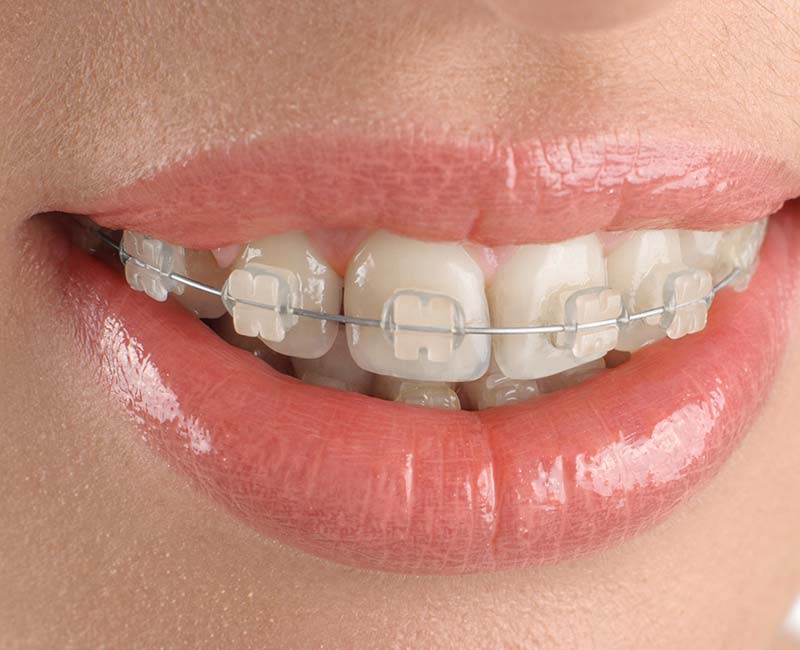Clear braces are similar to traditional metal braces. But because they’re made with tooth-colored materials, they’re less noticeable. Clear braces can correct the same orthodontic issues as metal braces, including overbites, underbites, crooked teeth and crowding.
Advertisement
Cleveland Clinic is a non-profit academic medical center. Advertising on our site helps support our mission. We do not endorse non-Cleveland Clinic products or services. Policy

Clear braces are a type of orthodontic treatment used to straighten your teeth. They can correct a wide range of orthodontic issues, including crooked, crowded, gapped and overlapped teeth. Clear braces are discreet and less noticeable than metal braces. Many orthodontists offer clear braces for adults and teens.
Advertisement
Cleveland Clinic is a non-profit academic medical center. Advertising on our site helps support our mission. We do not endorse non-Cleveland Clinic products or services. Policy
When you hear the word “braces,” you probably picture traditional metal braces. These dental appliances straighten your teeth using stainless steel bands, brackets and wires.
Clear braces work the same way as traditional metal braces. But they consist of ceramic brackets and frosted wires to match the shade of your natural teeth. As a result, clear braces are less noticeable compared to metal braces.
Clear braces aren’t as strong as metal braces. For this reason, it may take slightly longer to straighten your teeth using clear braces.
Note: There’s also a difference between clear bracket braces and clear orthodontic aligners (such as Invisalign® and ClearCorrect®). While clear braces use components similar to metal braces (like brackets and wires), orthodontic aligners are removable plastic trays that fit snugly over your teeth. Both have pros and cons. Talk to a dentist or orthodontist to find out which option is best for you.
Yes. Clear braces are just as effective as traditional metal braces. They just use different materials. But as mentioned above, it might take longer to straighten your teeth with clear braces.
Orthodontists use clear braces to correct a wide range of misalignment issues, including:
Advertisement
In addition to boosting your confidence and self-esteem, clear braces help improve oral health and function. When your teeth aren’t aligned properly, it can increase your risk of cavities and gum disease. It’s more difficult to clean teeth when they’re crowded or overlapped. Proper alignment also reduces your risk of chewing issues.
First, you’ll need to visit a dentist or orthodontist for an examination. They’ll check your oral health and see if you’re eligible for clear braces. If you have extensive tooth decay, gum disease or gum recession, the dentist will need to treat those issues first. Attaching braces to teeth that aren’t healthy can lead to a host of other dental problems.
If your dentist thinks you’re a candidate for clear braces, they’ll probably refer you to an orthodontist — a dentist who specializes in straightening teeth.
Your orthodontist bonds the clear ceramic brackets to the front surfaces of your teeth using a special dental cement. Once the brackets are in place, your orthodontist attaches a tooth-colored wire to the brackets and anchors the wire using metal bands on your back molars. Finally, they’ll add clear elastics to your brackets to keep the wire firmly in place.
In most cases, it takes about one to two hours for an orthodontist to place clear braces.
After your clear braces are on, you may experience slight tenderness and discomfort. These side effects are normal and should go away in a few days. In the meantime, you can take over-the-counter pain relievers, such as acetaminophen or ibuprofen, to ease your symptoms.
You’ll also need to steer clear of hard, crunchy or sticky foods, which can dislodge or break your ceramic brackets. Your orthodontist will provide you with a list of things to avoid.
Clear braces, while not invisible, are still far less noticeable than metal braces. This is the main reason why some people choose clear ceramic braces.
Clear braces are more prone to staining compared to traditional metal braces. To reduce staining:
Compared to traditional metal braces, clear bracket braces are more fragile. They tend to break more often. To reduce this risk, follow the dietary restrictions outlined by your orthodontist.
Clear braces are usually more expensive than metal braces because of the materials used. Keep in mind that clear braces are also more fragile, so it’s possible you’ll have to pay more for repairs.
Advertisement
On average, it takes between 12 months and 36 months to straighten your teeth with clear braces. In comparison, it takes an average of 20 months to complete treatment using metal braces. The length of treatment depends on the severity of misalignment.
Your orthodontist will give you a list of foods to avoid as well as foods you can eat.
There are many foods you can still enjoy while wearing clear braces. Here are just a few examples:
Pasta.
Oral hygiene is always important, especially if you wear braces. Here are some tips for keeping your mouth clean and healthy:
Advertisement
If you’re concerned or self-conscious about tooth misalignment or malocclusion, talk to a dentist about treatment options. There are several dental treatments that can improve the appearance, health and function of your smile. Your dentist can help determine which one is right for you and your oral health goals.
Clear braces work just like metal braces, but they’re less noticeable. While clear braces can correct a number of orthodontic issues, they’re not right for everyone. To find out which treatment options are best for you, schedule a consultation with a dentist or orthodontist.
Advertisement
Dentistry plays an important role in oral health. Cleveland Clinic’s experts can design a personalized plan that will keep you smiling for the long haul.

Last reviewed on 07/25/2022.
Learn more about the Health Library and our editorial process.